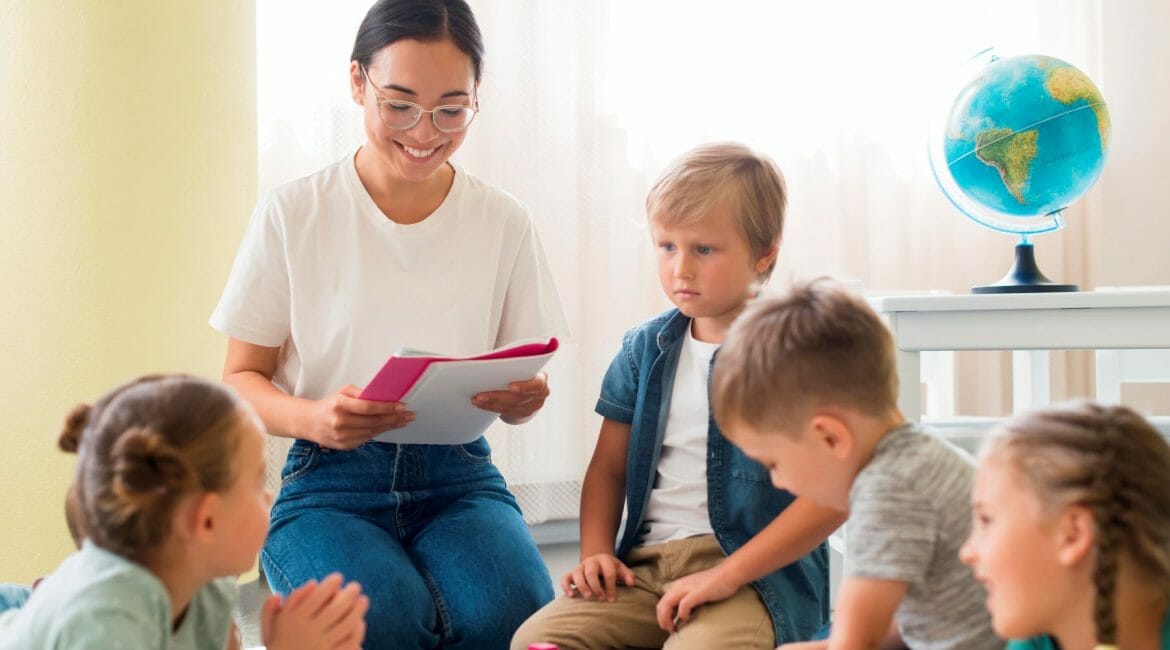Teachers are always looking for new and innovative ways to reach their students. We often reach for the newest technology and teaching methodologies for assistance, but facilitating learning is far simpler than that. We know that what students really need to succeed is to feel welcome and included. A student’s attitude can shape their entire academic career. A wonderful way to reinforce positive attitudes is through inclusive teaching.
Inclusion in education allows students to feel comfortable with both the lesson and their classroom communities. The benefits are substantial, and they can stick with us for life. Let’s look at some of the ways we can incorporate inclusive teaching into our everyday lesson plans. Before we do, we’ll dig a little deeper into what inclusive teaching is.
What is Inclusive Teaching?
When you look at your classroom, what do you see? If you’ve got a diverse student body, you probably see students from all different walks of life. You may see students from a number of different cultural and socioeconomic backgrounds. You’ll also probably see students with different intellectual, emotional, developmental, and physical abilities.
Whether students differ based on language, ability, behavioral needs, or sexual orientation, each learns in a slightly different way. That’s because each students’ life situation results in connections with different things. Identifying and accepting those differences is at the heart of inclusive teaching.
At its simplest, inclusive teaching is teaching in a way that makes all students feel included. That means creating an environment where students feel valued and comfortable and unafraid to participate. It takes a little work, but there are strategies that can help you get where you want to be. Before we dig into strategies for inclusion, I’d like to touch on why inclusive teaching is important.
How Inclusive Teaching Benefits Students
All students deserve the same chance at a quality education. Due to different ability levels among students, this hasn’t always been an easy thing for teachers to provide. Inclusive teaching is a fantastic way to ensure all your students are able to reach their full potential. Let’s look at some reasons inclusive teaching is such a powerful tool in a diverse world.
Inclusive Teaching Helps Build Confidence
One of the scariest parts of participating in any activity is the fear of rejection. We feel that if we don’t perform well or get the wrong answer, people will judge us. Add in the fact that we may look, act, or speak differently from others, and this fear can become crippling.
One of the best ways to overcome that fear is to actively participate. We learn that there’s really nothing to be afraid of. Also, for the most part, most people will be kind to us if we make a simple mistake. The more we are exposed to these situations, the more we develop self-esteem and confidence.
When students have confidence, they are more willing to learn and challenge themselves. They’re also better able to overcome obstacles they encounter throughout their learning journeys. One of the greatest learning benefits that comes with building confidence is that it can actually help us improve comprehension.
Inclusive Teaching Helps Improve Comprehension
Confidence and comprehension go hand in hand. When students lack the confidence to speak up or answer questions, their comprehension can suffer. This is a vicious cycle that teachers have been battling seemingly forever. Luckily, inclusive teaching can help students improve their comprehension.
Beyond confidence building, another reason inclusive teaching methods help improve comprehension is that it involves finding ways to connect. Students have a hard time comprehending materials if they have nothing to relate it to. By getting to know students and tailoring lesson plans to the way they learn, no child is left behind.
That means connecting to students, no matter their situation. ESL students may benefit from lesson plans that involve their native tongues or cultures. Physically disabled students may benefit from lessons that showcase differently abled students succeeding. Any time we can involve the things a student holds near and dear is an opportunity to reach them on another level.
Inclusive Teaching Helps Foster Positive Attitudes Toward Learning
When we take the fear out of the classroom, we allow students to enjoy the experience. Removing the anxiety barrier allows us to be in the moment. When we are overly focused on insecurities, we can’t fully focus on our studies. This can lead to negative associations with school and learning in general.
Inclusive teaching focuses on the strategies that help alleviate those fears. The more we practice them, the less anxiety we’ll feel. The resulting positive attitudes toward learning can make all the difference in the world when it comes to a student’s success. If you’re ready to develop these benefits in your own students, it’s time to learn some inclusive practices that will make it happen.
Inclusive Teaching Strategies
The legwork that goes into making your classroom inclusive doesn’t need to be difficult. In fact, it should be fun. That’s the whole point. Inclusive strategies often involve sharing and expressing ourselves. Take it one step at a time, and you’ll see your vision come to life before your eyes. If you want to create a sense of inclusion, classroom strategies like these can get you there quickly.
Learn About One Another
Few activities cultivate a community like getting to know one another. This should be the first step, but it should also be an ongoing step. Building bonds takes time, so don’t rush through it. This step is crucial if you want your inclusive teaching endeavor to be successful. Here’s why.
Learning about who the people in our classrooms really are is what connects us. It makes us care whether or not the members of our little teams succeed or fail. It allows us to open up about our thoughts and feelings, and allows us to be open and receive the thoughts and feelings of others. Empathy goes a long way in all aspects of life, so take some time to cultivate it.
Simple exercises can get you there. Students and teachers share what makes them unique and what makes them the same. This may be accomplished through early semester ice breakers, show and tell, or by teaming up with one another. These activities build interest in and empathy for one another. That’s the first step toward inclusion. This is also an important step in creating group activities that deepen our understanding of others.
Get Students Involved in Group Activities
Participating in group activities is a really great way to involve students in inclusive learning. It’s also a great way to increase our knowledge of one another. Participating in activities with others forces us to think creatively and use our experiences to solve problems. As we share those experiences, it bonds us together.
Many of us make friends and create these bonds through teams. Whether we’re involved in sports, academia, or some other hobby, sharing our successes and failures together helps us grow together. When we have shared experiences with an emotional element, such as winning and losing, those shared emotions create a special bond. Create these same experiences through inclusion instruction in the classroom and your students will be set up for success.
Make the Classroom a Safe Space
Learning about one another is key to creating a safe and inclusive classroom for students to share and participate. As we’ve explored already, this builds empathy. The more we know about one another, the more we feel for them. Once you create a safe space for students, you’ll see them open up and shed their fear of being judged. Making this a reality will take a concerted effort.
Expectations must be set and understood by the entire class.It must be crystal clear to all students that judgment of others will not be tolerated. Students should show respect for everyone in the class, and should not bully or tease others for struggling or making mistakes.
Creating a safe and inclusive environment means that students get the experience they need to boost self-confidence. They also comprehend the materials better. That allows them to feel confident in their answers. This, in turn, will reduce much of the anxiety associated with participation in classroom activities. A safe and inclusive classroom rounds this all off.
Choose Diverse and Relevant Materials
Students tend to learn best when the material feels relevant to their lives. When they can see themselves in the narrative or see how something impacts their communities, the lesson sticks. They may even be more apt to become active participants in making changes that bolster their communities.
If you’ve taken the time to learn about one another, you already know what materials are relevant. Materials that reflect the cultural and socioeconomic makeup of the class will be particularly impactful. Make sure you build instruction based on unique and varied materials to keep students interested.
Another great way to ensure materials are relevant is to give students a voice. Let them take part in picking some materials. By allowing them to choose materials that are of interest to them may even take some work off your plate. You’ll spend less time getting them to focus and more time expanding their minds.
Vary Instruction Styles
As important as study materials are, instruction styles may be equally impactful. Some students learn better in one environment over another, and the only way to learn what works is to switch it up.
Outdated videos and heavy texts don’t generally foster students’ excitement. That can be a detriment to the learning process. Choosing to change it up is taking an active step towards ensuring students absorb information rather than parroting it back. So, what kind of alternatives are out there?
Games
Kids love games. That’s a fact. Games are seen by some as a waste of time, but there is increasing body of evidence to the contrary. When students are allowed to work games and play into their learning, they often show more motivation to learn and are more attentive. Not only that, but they can teach important problem solving and teamwork lessons. Don’t write games off. They are becoming an increasingly important part of the learning process, and can reinforce your inclusive teaching efforts.
Interactive Digital Activities
Another way to get students engaged is through interactive digital activities. Today’s students grew up on the internet and devices, so few things feel as natural to them. Incorporating activities that involve devices and apps can get them more excited than book and video learning alone.
Bring in Guest Speakers
One of the most powerful ways to get kids engaged is to bring in guests that they can connect to. Seeing people who look like us sharing their stories lets us know that we can accomplish more than we may think. They have the same struggles and similar backgrounds, and that’s an engaging combination.
If you need help locating guest speakers for your classroom, you’re in luck. Livestream Learning Studio offers inclusion resources to help you out. We deliver knowledgeable guest speakers via virtual events that maximize academic content engagement. Here’s how it works.
Livestream Learning Studio provides educators with a virtual learning platform for K-5 students that teaches academic content in ways that address all learning styles, across multiple subjects. We deliver a robust program catalog, differentiated for lower and upper elementary, with stress-free usability. Our literacy programs for grades K-2 and STEM programs for grades 3-5 create lasting impact in the classroom through our unique laugh-while-learning approach.
Utilize UDL Guidelines
In order for students to get the most out of their curriculum, it’s important that the materials are accessible. If a student can’t grasp the materials, it’s incredibly difficult for them to absorb or retain that information. That’s where UDL, or Universal Design in Learning comes in.
Universal Design in Learning principles are a way of identifying, addressing, and overcoming systemic barriers that lead to negative learning outcomes. That includes doing everything we can to provide flexible learning environments and learning spaces that allow learners of all ability levels to participate and succeed. It’s a key part of inclusive teaching and creating successful students.
Get the Support You Need
Teaching in an inclusive classroom will deliver tremendous benefits for all your students. Understanding the ins and outs of inclusive pedagogy, or the ways we consider student differences to engage them in meaningful, relevant, and accessible classroom instruction will make your inclusive teaching efforts more powerful. Get the support you need to provide your students with the support they need.





